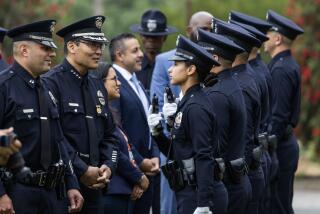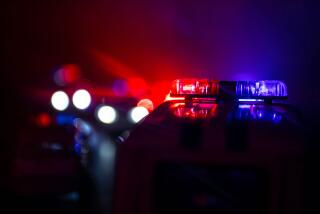Police Say Radios Too Low-Tech
The police radio used to be the ultimate piece of squad-car technology, as dependable to a cop in a jam as the trusty black-and-white cruiser itself.
But that was before sprawling office towers and parking structures started blocking radio waves. And before wireless phones--with their crystal clear reception--upped expectations for two-way communication, while at the same time stealing frequencies from radio users.
Now, it seems, in this era of technological innovation, the crackling police radio is starting to show its age.
Police and fire agencies across the country are using antiquated equipment developed in the 1950s and ‘60s that has failed in major emergencies, including the 1992 Los Angeles riots and 1993 Laguna Beach firestorm.
That problem is prompting departments to spend hundreds of millions on cutting-edge radio networks, only to encounter many new--and sometimes dangerous--breakdowns.
In one extreme case in Atlanta, a new police radio network failed to pick up an officer’s call for help just moments before a rifle-wielding suspect wounded her and killed her partner. In Delaware, firefighters resorted to shouting out of windows because their $50-million communications system didn’t work inside high-rise buildings.
In Los Angeles, police use a 21-year-old network so out of date that manufacturers have stopped making parts for it. For years, cash-strapped technicians had to cannibalize parts from some hand-held radios to fix others. The problems reached a crisis during the 1992 riots, when officers in the field faced a critical shortage of portable radios.
The city is installing a new system.
Orange County began rolling out an $80-million network earlier this year and experienced its own static--including several incidents that police insist put their safety at risk. This summer, Irvine officers complained that new radios failed to pick up critical information from dispatchers during an office building search for a murder suspect.
“I think we’ve gone backward instead of forward,” said Irvine Police Officer Jeff van der Sluys Veer. Some of his colleagues now rely on their own cellular phones and pagers, he said, “anything they can to maintain communications.”
The problem is part physics and part finances.
The design of police radio systems makes it difficult for signals to penetrate the heavy steel and concrete of office buildings, parking garages, shopping malls and even hospitals. As these structures sprout, they present major obstacles for officers trying to keep in touch with each other.
Wireless phones also operate with radio waves, but engineering experts say they often provide far better service than police radios because the telephone companies place more radio towers in highly developed areas. Local governments simply don’t have the money to match that kind of coverage--even with state-of-the-art systems.
The problems are being closely watched in cities across the nation. The Los Angeles County Sheriff’s Department, which also is building a new radio system, has hired a consulting firm to study the problems elsewhere and make recommendations.
The quality of radio service varies greatly--even among agencies purchasing the same type of advanced systems. San Diego’s new network is similar to Orange County’s, but officials there said they’ve experienced few problems and are generally happy with it.
In dozens of cities, however, police and fire officials have faced signal failures in patrol areas and inside malls, hospitals and even their headquarters. In many cases, the breakdowns have fueled cost overruns and triggered complaints that new radios are putting lives at risk.
“Our society has become such a technological monster that . . . public safety has just been overshadowed,” said Alan Burton, an Oregon-based consultant on emergency communications.
Police and fire departments were once leaders in communications technology. In the 1920s, Detroit police unveiled the country’s first one-way car radio. The development was quickly followed by two-way police radios. And soon, officers came to view their radios as an indispensable part of their crime-fighting arsenal.
Until the early 1990s, most police radios operated at frequencies that were 400 megahertz or less--the same frequencies used by the burgeoning wireless communications industry. The explosion of cell phones and other technology sparked a modern-day “land rush” for radio frequencies.
Police and fire departments found themselves without space to add radio channels although their populations--and emergency call volumes--were rising. As calls flooded dispatch centers, officers had to wait in line to make a call--often delaying response times by crucial minutes.
The answer was for police to switch to higher, less crowded frequencies. But as a growing number of agencies made the conversion over the last few years, the limitations with these frequencies have become apparent.
The biggest complaint is that the radios don’t always work in many big structures and throughout entire patrol districts. Experts say radio waves on higher frequencies cannot travel as far as those on the low frequencies previously used. To compensate, public safety agencies must add radio towers, which is often cost prohibitive.
Additionally, the technology is vulnerable to interference from wireless phone transmissions. Technicians have discovered that some cellular phone sites reduce nearby police radios to little more than static.
Fixing Problems Can Be Costly
Orange County began upgrading its system after years of complaints about slow response times, particularly during the Laguna Beach firestorm. But the initially promising 800-megahertz system quickly drew concerns.
In Tustin, for example, police couldn’t hear dispatchers while inside their own headquarters until officials installed extra equipment to help. In an effort to improve coverage in buildings and reduce radio failures outside, technicians spent thousands of dollars adding equipment to the Tustin police building and boosted the strength of radio signals in Irvine.
Worried county officials delayed expansion of the network for more than five months while technicians worked on the glitches. Other agencies are only just getting ready to join the system.
Officials said they won’t know the extent--or cost--of any additional improvements needed in Orange County until the entire system is up and running. Technicians hope it will be minimal, but other agencies such as police in Kansas City, Mo., and the Delaware State Police have placed the cost of patching holes in their new radio networks in the millions.
Despite the recent fixes in Irvine and Tustin, police continue to report that radios sometimes produce garbled messages and don’t work in some large buildings. Meanwhile, some officers say they worry that the snafus might presage the kinds of serious failures seen elsewhere.
‘This is supposed to improve public safety,” said Irvine Sgt. Dave Mihalik, “not make it harder.”
While no one has been hurt in Orange County, other agencies report more serious breakdowns.
“Dead spots” are reported elsewhere, including Portland, Ore., where a new 800-megahertz radio network was touted as state-of-the-art technology when it was installed in 1994.
In July, the Oregon OSHA fined the city $3,600 after determining that the radio system was already overtaxed and that failures sometimes prevent police officers from calling for help.
“Officers are disgusted,” said Sgt. Lonn C. Sweeney, who filed the complaint. “I couldn’t look my officers in the eye and send them out on the street.”
One horror story cited about the potential danger of radio failures occurred in Atlanta on Oct. 12, 1997. That evening, two patrol officers confronted a man accused of hitting his girlfriend. The suspect quickly became aggressive, and one of the officers--Patricia Cocciolone--later testified that she radioed for help. But the call was never heard.
Moments later, the man emerged from his apartment with an assault rifle and unleashed a volley of shots. Cocciolone suffered wounds to her head, hip and hand. Her partner, Officer John Sowa, was killed.
Though it’s arguable whether the call could have saved the officers, the episode shocked colleagues and focused attention on the transmission dead spots, said Chip Warren, vice president of the International Brotherhood of Police Officers, which represents Atlanta officers.
“This is putting officers’ lives in danger,” he said.
Yet building a radio system that will cover every inch of a city at all times is virtually impossible, especially those with large buildings or hilly areas, according to radio technicians.
“There are just places that radio waves won’t go,” said Pat Sturmon, a spokeswoman for Motorola Inc., which manufactures public safety radios. “If you have a budget, you can design anything you want it to do. But no system is perfect. There are always going to be dead spots in any system.”
In 1995, police officers and firefighters in Kansas City, Mo., determined that their new, $18-million radio network failed in many areas of the city.
Frustrations soon erupted. Firefighters said the radios were so unreliable inside hospitals, malls and large apartment complexes that some had stopped taking them on calls.
One firefighter claimed his radio failed while he was in a burning building, forcing him to leap through a first-floor window to escape the flames.
In another case, two police officers said their radios failed to work when they were each shot during a foot chase. One of the wounded officers had to run in circles just to find a spot where the radio would work so he could call for help, they said in court records.
An independent review of Kansas City’s communications system blamed weak signal strength for the problems and recommended adding antenna sites throughout the city. The cost to taxpayers to fix the problems: $10 million.
Sheriff’s Officials Learn From Others
The seriousness is not lost on officials overseeing similar upgrades in Los Angeles.
In addition to hiring a consultant, the Sheriff’s Department is talking to officials in Irvine and elsewhere to better understand the shortcomings of their systems and how to get the best possible coverage.
“We’re going to look at what other people are doing,” said Sheriff’s Capt. Robert Sedita, who runs the department’s communications and fleet management bureau. “People who have already gone through this have learned a lot.”
The goal is to prevent similar problems--but many experts doubt that is possible as wireless phone sites mushroom to meet the relentless demand for personal communications.
And until engineers can build the “perfect” system, experts said, officers must continue to take into account the problems with coverage when using the radios. In some cases, that means requesting backup during even the most routine calls in areas where radio coverage is patchy.
“I haven’t been encouraged that there is going to be a lot of improvement,” said Harlin McEwen, chairman of the International Assn. of Police Chiefs’ communications and technology committee.
“As [public safety] technology gets better, the rest of the world is not sitting still. . . . You give up old problems for new ones.”
(BEGIN TEXT OF INFOBOX / INFOGRAPHIC)
Static Over Police Radio
Police officers using Orange County’s new 800-megahertz radio system report that missed calls from dispatchers, garbled messages and dead spots in office buildings threaten safety and response times.
*
OLD SYSTEM: 400 MEGAHERTZ
Longer wavelength travels better over hills and around buildings.
Lower frequency travels twice as far as new system
*
NEW SYSTEM: 800 MEGAHERTZ
Shorter wavelength delivers a clearer signal. But some agencies report the signal has difficulty penetrating buildings.
Higher frequency needs extra towers to reach same distance covered by old system
*
Source: Irvine Police Dept.; Alan Burton, emergency communications consultant *
Graphics reporting by BRADY MacDONALD / Los Angeles Times
More to Read
Sign up for Essential California
The most important California stories and recommendations in your inbox every morning.
You may occasionally receive promotional content from the Los Angeles Times.











